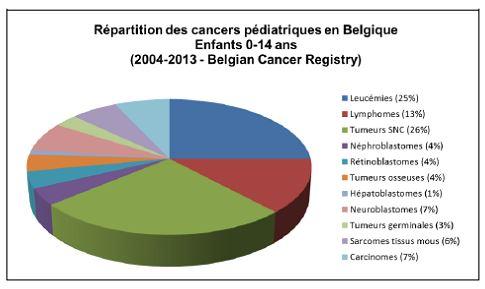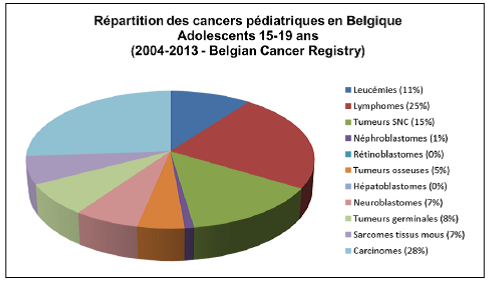Cancer in children

The section on pediatric cancers is not exhaustive. The aim is to give you an overview of cancers that affect children. It is essential that you ask the care team if you have any medical questions.
Why a cancer?
We are all made up of billions of cells which are the bricks of the human body. Cancer develops when one cell starts to multiple uncontrollably. Gradual changes in the genes of the “unhealthy” cell cause dysfunction in the regulation of the cell multiplication process. These changes in the genes do not occur in the other “healthy” cells. In the vast majority of cases, they occur after birth and are not passed on by the parents. For all of these children, there are therefore no risks of the recurrence of cancer in the family.
What is the etiology of cancers?
In the majority of cancers, the etiology or precipitating factors are not identified (Chan et Raney, 2010). Numerous research projects are under way to try and identify the factors underlying the origin of cancer.
How common is cancer?
Childhood cancers are a rare disease accounting for only 1% of all cancers.
On average, 13 new cancer cases are diagnosed every year in Belgium among 100,000 children under the age of 15. That means that, in Belgium, 300 to 350 children develop a leukemia or malignant tumor every year (Institut Roi Albert II, s.d; Belgian Cancer Registry, 2013).
The pediatric hematology and oncology department of the Saint Luc university clinics manages 25% of the new cases of childhood cancer reported each year in Belgium. In 2015, we welcomed approximately 75 new patients and carried out 13 stem cell transplants.
The most common cancers in pediatric hematology and oncology are leukemia and lymphoma. This is followed by brain tumors, embryonal tumors such as neuroblastoma, nephroblastoma and retinoblastoma, and lastly, osetosarcomas and rhabdomyosarcomas.
The graphs below shown the frequency of pediatric cancers in Belgium for children and adolescents.

Distribution of pediatric cancers in Belgium – Children, 2004-2013 (From the "Belgian Cancer Registry, 2015")

Distribution of pediatric cancers in Belgium – Teenagers, 2004-2013 (From the "Belgian Cancer Registry, 2015")
The distribution and biological features of pediatric cancers vary according to the age of the child (Pritchard et al., 2013). All age groups are affected. However, almost half of pediatric cancers concern children under the age of 5 (Imbach et al., 2014). Each tumor has a preferred age of onset: for example, we find more nephroblastomas, neuroblastomas and rhabdomyosarcomas during early childhood (0-2 years), whereas bone tumors and lymphomas tend to appear more during later childhood (2-12 years). Certain cancers that are rarely seen in young children are more common in adolescents. This is the case with Hodgkin lymphomas, bone tumors as well as thyroid cancers and melanomas (Sommelet, Clavel & Lacour, 2009; Imbach et al., 2014).
What are the characteristics of pediatric cancers?
The malignant tumors seen in children are very different from those seen in adults.
Location
The most common locations of cancers in adults (lungs, breasts and female reproductive organs, digestive tract and skin) are rare in children.
Environmental factors
Although environmental factors, such as smoking, are responsible for a high number of cancers in adults, they do not play a role in the occurrence of tumors in children.
Histological type
The histological type is very specific as carcinomas, which account for the vast majority of tumors in adults, are hardly ever seen in children. In children, in addition to leukemias and lymphomas which account for 45% of malignant tumors known as “embryonal”; in fact these are tumors which , under the microscope, look like the corresponding embryonal tissue. Next are sarcomas, relatively close to those seen at an older age.
Progression
The progression of tumors in children is also very different to the progression seen in adults. These are rapidly growing tumors, which is largely due to the high percentage of cells involved in a division cycle which can reach 80-90%. These tumors also regress very quickly under the effect of chemotherapy and radiotherapy to which they are very sensitive.
How do cancers progress?
Currently, 80% of children with cancer can be cured.
Treatment requires immediate management by an experienced team specialized in childhood cancers: this is to provide the optimal treatment with a view to obtaining a cure but also to ensure the patient has a good quality of life.
Today, the 5-year survival rate for childhood cancers is close to 80% for all pediatric cancers (Imbach et al., 2014). It is even as high as 90% for certain forms of acute lymphoblastic leukemia, the most common cancer seen in pediatrics.
Even though considerable progress has been made in the medical management of young patients with cancer and an increasing number of children and adolescents are surviving cancer (Gatta et al., 2009), it remains the second most common cause of death in children under the age of 15 in the United States (National Center for Health Statistics, 2010).
